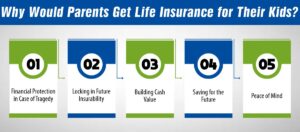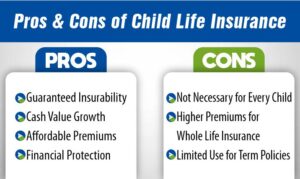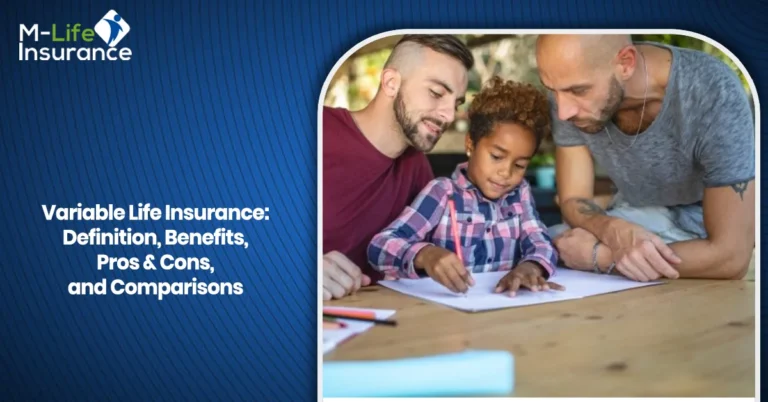Last Updated on: January 14th, 2025
Reviewed by Dylan Whitman
- Licensed Agent
- - @M-LifeInsurance
Can You Get Life Insurance for Kids? When you hear of life insurance, you would think of adults since it is a common policy among them, but it is possible to get children’s life insurance policies. It is a choice most parents make for different reasons, and as much as it may not be compulsory to have life insurance for your child, there are some benefits that anyone should consider getting a life insurance policy for a child. This comprehensive article will discuss the nitty-gritty of investing in life insurance for children and how it helps, the kind of policies offered, the price range, and a lot more. Should you consider getting life insurance for children, you will get your answers and all the information you want in this article.
Table of Contents
Toggle
Why Would Parents Get Life Insurance for Their Kids?
As much as life insurance can be taken as an irony, there are some reasons why parents might consider purchasing life insurance for their children. Having a life insurance policy for a child might not be as important as it seems, primarily because the focus is given to what many people consider life insurance to be about. Here are the key reasons parents might consider getting life insurance for their kids:
1. Financial Protection in Case of Tragedy
- Unexpected Expenses: The worst thing that could happen to any parent is to lose a child. If such events occur, they are very special and cause great emotional distress, and extra costs place extra stress. Expenses for funerals, bills for medical treatments, and all other related costs are taken care of by life insurance.
- No Financial Burden: If there is no life insurance, the parents may be forced to borrow this money, or simply pay it out of pocket at the times when they are mourning. This means that life insurance assists in cushioning families from further hardship so that they can be able to concentrate on other key aspects such as looking for health solutions.
2. Locking in Future Insurability
- Guaranteed Coverage for the Future: Sickness is very unpredictable, and at one point in life, an individual might be plunged into health complications that may make it hard for him or her to attain life insurance when he/she is an adult. Parents who buy life insurance for a child while they are young protect their child, knowing that whenever their child wants to get insurance, he or she will be insured.
- Affordable Premiums: Child life insurance premium is preferable to be installed seeing it is a low-risk proposition in comparison to adults. This makes it possible for the parents to be able to sign up for lower rates that cannot be higher in the next years.
3. Building Cash Value
- Growth Over Time: Some kinds of life insurance include whole life products that transform the contributions made to it into cash value as time progresses. Money demanded under the policy has grown at a guaranteed rate so one can use the money at a later stage in life.
- Loans or Withdrawals: If the child eventually grows into an adult, the cash is available to be encashed or borrowed whenever the child needs to pay for important milestones in his or her life such as buying a car, going to college, or even buying a first home. This means that life insurance becomes not only a protective device but also a financial value in the future.
4. Saving for the Future
- Investment in Their Future: The children’s life policies serve as long-term saving instruments. Some policymakers can be chosen whereby parents pay a specific amount to receive the policy for a specified number of years let us say 10, or 20 years then the policy remains valid for the lifetime of the child.
- Educational and Financial Support: The policy’s cash value can be used to cope with critical events in life Read More button. For instance, it could be used for paying college tuition fees or contributing to a down payment on a home and so provide the clients with a worthy financial security.
5. Peace of Mind
- Emotional Relief: But, even the decision to think about life insurance for children is not easy and may bring tears to parents’ eyes, however, having some kind of a guarantee can be helpful in many situations. They also provide money security as parents know they can deal with the unforeseen The following are some of the assurances that can be provided;
- Less to Worry About: People can pay for a life insurance policy and be reassured, as parents, that they don’t have to worry about their child’s life being cut short because they are protected.
What Is the Best Life Insurance for Kids?
When it comes to choosing life insurance for children, there are two primary types of policies available: There we have whole life insurance and term life insurance. Both types have their advantages, and what is best for you depends on your needs from the policy and your wallet.
1. Whole Life Insurance for Kids
Whole life is another form of permanent insurance policy that is issued for the life of the child if only premiums are routinely paid. This policy also carries added value in terms of the build-up of cash values. An amount of the premium is invested in a savings fund which is tax-privileged and can be withdrawn later. Whole life insurance is sometimes more costly than term life insurance, yet pays deserved dividends in the long run.
Parents prefer whole life because the insurance amount increases over time, thus it also acts as an investment to parents. Once the child becomes an adult, one can use the cash value in areas like clearing student’s balances or buying his/her first life policy.
2. Term Life Insurance for Kids
Term life insurance is another type, but there’s only a fixed death benefit, usually 10, 20, or 30 years. An endowment policy does not create cash value, but it is often cheaper than whole-life insurance or still life. Term life insurance may be very valuable for you if you need temporary insurance, for example, to guarantee the family’s financial security in case the child dies during the term of insurance.
The term life insurance also can be renewed or exchanged for a whole life policy but will cost more if it is taken as the child grows up.
Factors to Consider When Buying Life Insurance for Kids
When buying life insurance policies for your children, several considerations should be made for the policy to fit their desires and needs. Analysis of these factors can assist you in making a rational decision in choosing the right cover for your family. Below are the key considerations:
1. Age of the Child
- Younger Children Require Less Coverage: In most cases, young people need smaller amounts to cover since they have more years to live and are not likely to get sick. Nevertheless, it is possible to start the policy for a younger child, which has such pluses as considerably lower cost and insurance amount fixation in the future.
- Locking in Low Premium Rates: In general, the earlier you buy life insurance, the cheaper the rates will be since children are the least likely to die. Some policies may be looked at when the child is young and locking the rates at a low price for the entire time would have been made.
2. Purpose of the Policy
- Covering Final Expenses: in case of accidental death, the policyholder has to provide for the funeral costs and other related expenses, working with a $10,000 to $50,000 limit should suffice. This can help to cut costs for parents while not necessarily overwhelming with extensive coverage.
- Building Cash Value: If the goal is to have say liquidity value or savings for a child in the future, then a bigger policy might suit. Some policies such as whole life insurance save cash value in the long run and can be used to cater for qualitative purchases in life such as college fees, or even to deposit a home. These policies have relatively expensive premiums and are characterized by considerable financial gains in the future.
3. Family Size
- Coverage for Multiple Children: If you have several children, it’s necessary to review the overall amount of the life insurance for the whole family. Sometimes it could be a wise decision to group all the family members under one policy while in some other situations preferred was to get a policy for each kid.
- Separate Policies for Each Child: In a family that has only one life policy to cater for a single parent and two children it is better to have two policies, one for the child. Thus, every child gets personal attention, irrespective of whether the need is for lifetime coverage, for an investment tool generating cash value, or simply for the objective of meeting final expenses.
Life Insurance for Kids Cost
In most cases, child life insurance is much cheaper in comparison with adult one, which allows parents to eventually protect their kids and have no worries. Childhood premiums, however, can range from $5 to $20 a month for children’s life insurance coverage. Nevertheless, some factors that are involved in the costs include the type of policy, the coverage amount, the age and health of the child, and the insurance company to deal with.
– Factors Affecting the Cost of Life Insurance for Kids:
- Policy Type:
This is because a whole life insurance policy costs higher than a term life insurance policy, because of the permanent coverage offered by a whole life insurance policy and the cash accumulated over the policy’s life. Term life insurance is cheaper, and it offers more coverage for a particular number of years, 10, 20, or 30 years for instance.
- Coverage Amount:
The highest limit that is provided to cater to every individual case will attract higher premium rates. For instance, getting a $50,000 policy will be cheaper than getting a $10,000 policy. However, opting for a higher limit can add more protection to a family in case a disaster occurs.
- Child’s Age and Health:
Premiums differ mostly with the age and health status of the child. A young and healthy child will be in a position to get a better deal since he or she will attract a lesser amount of premium. On the other hand, if a child has some form of complications or is a high-risk candidate, then the premiums may be slightly higher.
- Insurance Company:
The various insurance companies have made available different rates for the premiums they charge. Companies such as MetLife, Mutual of Omaha or Insure Final Expense focus on children’s life insurance policies and, for this reason, can offer interesting rates. This means that, before you settle for an insurer, you need to compare the various quotes they offer you.
– Table of Life Insurance for Kids Cost:
| Policy Type | Coverage Amount | Average Monthly Premium | Key Features |
| Term Life Insurance | $10,000 – $50,000 | $5 – $15 | Affordable, temporary coverage for a specific period (10-20 years). No cash value. Suitable for covering final expenses. |
| Whole Life Insurance | $10,000 – $50,000 | $15 – $30 | Permanent coverage with cash value accumulation. Higher premiums, but the policy lasts a lifetime and builds savings. |
| Universal Life Insurance | $10,000 – $100,000 | $20 – $40 | Flexible premiums and death benefit amounts. Cash value grows over time. |
| Final Expense Insurance | $5,000 – $25,000 | $5 – $20 | Specifically designed for covering funeral and final expenses. Smaller coverage amounts, often with no medical exams. |
Life Insurance for Kids with Pre-Existing Conditions
- Consider coverage options: It appears that certain policy types, such as whole life insurance, may be offered to children with specified health issues and accumulate cash value as time elapses.
- Understand policy terms: Be sure to read all the terms very carefully, particularly in so far as the exclusion of pre-existing diseases is concerned.
- Check for age limits: They may also limit the coverage by age, so make sure that your child can be insured at all.
- Look for riders: Certain policies may have optional accessories known as riders which increase coverage or provide special features for children with medical conditions.
- Talk to an agent: If you want to learn more about specific life insurance types for children or certain products you need the help of an insurance agent.
- Evaluate long-term needs: Think if your child is going to be lucky with the policy as age advances to insurability, costs, etc.
Do I Need My Kid’s Social Security Number for Life Insurance?
As with any other form of insurance, when filling out the application for life insurance for your child, the insurance company is going to require the child’s Social Security number. This is standard practice to ensure that the child being registered is genuinely claimed by the policy owner, the policy is valid and the insurer needs to be able to follow subsequent claims or entitlements. That is a very significant measure taken to ensure that all the occurrences are recorded and dealt with.
How Much Does Life Isurance Cost?
- Identity confirmation: This aspect makes sure that the insurer can be in a position to confirm your child’s identity.
- Legitimate policy: Variables that uphold the legal tender characteristics of the insurance policy, hence ensuring that it is issued correctly and legally.
- Tracking future benefits: This enables the insurer to have notes of all the possible claims, benefits, or any form of payout in the future.
- Prevent fraud: This may reduce the risk of becoming a victim of identity theft or insurance fraud.
- IRS requirements: The number is used for taxing the business and hence must meet the set government standards.
How Long Do You Keep Life Insurance for Kids?
Usually, there is no fixed period for children’s life policies To give an example, permanent insurance will differ from term insurance. General features of whole and term life insurance Whole life insurance remains in force throughout the life of the child if premiums are paid When the policyholder dies, the face amount of the policy, in this case, is paid to the policy beneficiaries Term life insurance only exists for a specified number of years, for example, 10, 20 or 30 years. In case you choose the term policy, you will be faced with the problem of either surrendering the policy or renewing it. Some parents retain the policy till the child is an adult and others might cancel the policy when the child is of working age.
- Whole life insurance: They feature lifetime coverage for the child as long as they make the premium payment.
- Term life insurance: Tenure is expressed in time, which means coverage is for a specific term, like 10, 20, or, 30 term years, etc.
- Renewal decisions: Again, with term policy one has the option of either rolling over the policy when the term gets to expiry or expiring the policy.
- Adulthood considerations: Parents may keep the policy for the child until the child can financially support him/herself.
- Premiums and responsibilities: When the child gets to adulthood, he/she must accept it, get an individual insurance cover, or reject it.

Pros and Cons of Child Life Insurance
Every financial action implies a certain list of pros and cons, and buying child life insurance is no exception. Here’s a more detailed breakdown to help you assess if this option is the right fit for your family:
Pros:
- Guaranteed Insurability:
Child life insurance has also the advantage of being able to secure coverage for the child at any time without worrying about his or her future health condition. If your child gets certain health issues in the future, he or she will not be turned away, or asked to pay a much higher insurance price. This is very reassuring for parents who have anxiety over the future general health of their child.
- Cash Value Growth:
Whole life insurance policies especially, provide for the creation of the cash value over the years; this is like a savings that is within the policy. It can be used later for loans or withdrawals providing an extra benefit of potentially having money to turn to when the child is an adult. It can also be used as an instrument for financial requirements like going to college or as a down payment on a house.
- Affordable Premiums:
It is cheaper for children to pay for life insurance premiums compared to when it is done by adults since children do not have diseases. Purchasing a policy while young allows a parent to pay less for the policy which can remain low even in the policy’s lifetime. It can be a rather cheap way of creating long-term financial security.
- Financial Protection:
Although many people consider it rather unpleasant to think about life insurance for children, this option is rather helpful if the unexpected happens. This coverage helps to have funeral expenses paid and other bills met thus having that peace that is needed during such a trying moment. Besides, it can save parents from some financial turmoil when they are already overwhelmed emotionally.
Cons:
- Not Necessary for Every Child:
Not every child will require life insurance. This then means, that in case you come from a well-off family with no major health issues, child life insurance may be unnecessary. There are other types of savings, or as it is often called, child financial planning, that many families do not opt for life insurance for children. One should take time and assess your family’s financial status before making the choice.
- Higher Premiums for Whole Life Insurance:
Indeed, there is the whole life policy where the policyholder’s coverage is assured from when the policy is purchased to the time of their funeral and the cash values will also be growing permanently but it costs way more than term life insurance. It is for this reason that if the main objective is to have coverage in the event of an untimely demise then term life insurance may be beneficial for your family financially. Despite the long-term advantages of whole life insurance, they entail costly premiums whiwhichrd to meet by sofor families.
- Limited Use for Term Policies:
As for buying a term life insurance policy for a child, what you get is temporary. In the event your child dies after the term, the policy ceases and no amount of cash value accumulates. What this means is that you cannot get any value added to the money that you invested in the policy, in case the policy is not renewed or is not converted into a permanent policy. Thirdly, while the agreed term expires, your child will eventually need to shop for an insurance policy at a higher price depending on his current health condition.
Every parent surely considers whether child life insurance is an answer to these questions; Here are things you should think more from points of view of long-term financial status, future requirements of your child,d and the financial strength of your family. Another reason to recommend calling an insurance agent or a financial advisor is to select the appropriate option for your family.
Conclusion about Can You Get Life Insurance for Kids?
Purchasing a life insurance policy for a child is not on the list of priorities for every parent, but it is useful in several aspects, such as providing financial protection, securing the child’s insurability in the future, and accumulating cash values. When using whole or term life insurance on kids, one must look at his/her current and future situations as well as those of your family. Many attractive companies include Met Life Insurance for Kids or Mutual of Omaha Life Insurance for Kids, and with many different options to choose from, your child’s future is financially secure.
FAQ’s of Can You Get Life Insurance for Kids?
1- At what age is it possible to receive whole life insurance?
Whole life insurance for a baby is normally available for anyone who is 14 days old and above.
2- At what age is life insurance possible?
The minimum age to purchase life insurance is usually between 14 days.
3- Is it possible for me to purchase life insurance for my 40-year-old son?
Absolutely yes, you can take an adult child life insurance although the policy will not be similar to one that will be taken for a child.
4- What is the minimum age to get insured?
This means that for a child as young as 14 days, one can take an insurance policy on the child.
5- When do you let go of life insurance?
Parents tend to surrender the life insurance policies once their children are grown-ups, however, there may be some specific reasons why, for instance, policyholders let the policy remain active for factors such as saving toward a kid’s life assurance or perhaps using the policy for future insurability.
Resources

Joyce Espinoza, Expert Life Insurance Agent
Joyce Espinoza is a trusted life insurance agent at mLifeInsurance.com. She’s been in the insurance industry for over ten years, helping people, especially those with special health conditions to find the right coverage. At MLife Insurance, Joyce writes easy-to-understand articles that help readers make smart choices about life insurance. Previously, she worked directly with clients at Mlife Insurance, advising nearly 3,000 of them on life insurance options.




